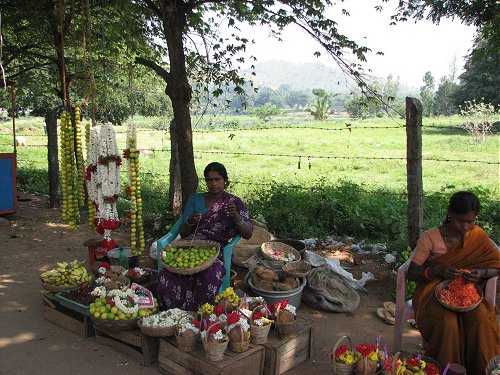Srirangapatna in Kannada Classics
by Dr. Jyotsna Kamat
First Written: May 2007
First Online: August 22, 2010
Page Last Updated: December 07, 2024
Srirangapatna 400 Years ago. Shrirangapattana (Population 23,500) today is a sleepy town, 24 Kilometers from Mysore on Mysore -- Bangalore Highway. But it has glorious past. It was a capital city of Wodeyars of Mysore and later Hyder Ali and Tipu Sultan till the latter's fall in 1799 CE. It is on the bank of river Kaveri, known as Ganga of South India Several Hindu rituals are performed on the confluence where the sacred river branches out. Sriranganath an avatar of Vishnu is the presiding deity of the town after whom the place is named.
The Sriranganath temple in Srirangapatna was constructed in 894 AD under Ganga rule. It was enriched under the Hoysalas, Vijayanagar and Wodeyar Kings of Mysore. Tipu Sultan has also donated ornaments to the deity. The Huge reclining idol in Yoganidra pose is also known as Adi Ranganatha or first, (primordial) Ranganatha, since exactly similar idol and temple came up in Shrirangam (Tamilnadu) later.
Kanthirava Narasarajavijaya, a Kannada classic composed by poet Govinda Vaidya in 1648 CE gives vivid description of the life around Kaveri and the city. King Kanthirava Narasaraja was the most illustrious, among early Wodeyars of Mysore.
Vikas Kamat/Kamat's Potpourri
Ranganathaswamy Temple, Srirangapatna
Mornings and evenings on the banks of Kaveri were beautifully picturesque. It was dotted with devotees who belonged to different sects. There were those who took holy dip. Some performed Sandhyavandana. Women in groups, a little away, were seen applying turmeric and Kumkum after bath. Some were applying collyrium (mascara) and some were seen dressing their wet hair. There were those who worshipped mother Kaveri, with usual offerings. Some women carried Kaveri water in bright and glistering pots, balancing, prettily on their heads.
There were Shaiva devotees who bathed Shivalingas and applied Vibhuti. There were Haridasas who applied nama after holy bath. Shrivaishnava devotees put on tirunamas and meditated on Hari. This sect was predominant as the priests of Sri Ranganatha temple were Shrivaishnavas since Hoysala Vishnuvardhana appointed them.
Daily puja itself was a grand affair to the deity and idol of Laxmi, sitting by the feet. Bath, anointment dress, ornamentation, flower-decking were carried on, with elaborate rituals. Food and betel were offered, fanning was done, service of dance and music offered, with devotion mixed with fanfare.
Several other temples also existed in Shrirangapattana. Gangadhara (Siva). Narasimha, Tirumala Venkateshwara and Hanuman temples attracted devotees. The king attended important festival-pujas.
Virasaiva mathas existed side by side with Shrivaishnava mathas.
Jagate was played every hour to indicate time, which was heard in the whole city.
The fort and ramparts shone like beautiful teeth of Puralaxmi (Goddess of the city). The Kirtimukha or lion-face appeared tall enough to devour the deer on the moon. Guns fixed on the ramparts were named Chamundi, Rama, Hanuman and Bhairava (battle-king).
There were special residential quarters for the citizens of Shrirangapattana. There were houses of learned people who interpreted Vedas, sastras and puranas. There were astrologers, poets and play wrights. Tall buildings of ministers and accounts officers existed nearby, abuzz with middle men and officials.
Streets of musicians, dancers, singers, comedians and professional singers along with those of perfume-sellers, barbers, painters, metal craftsmen, wrestlers, weavers, were built systematically. Special mention may be made of tailors who designed and stitched fashionable and ornamented headdresses (Kulavis) along with trendy cloths.
There were shops and stalls (malige) of highly skilled goldsmiths who worked on innumerable designs of pearls, corals, emeralds, bluestones, diamond ornaments.
Of Bogars who prepared plates, pots, bells, and aratis, lamps had glistening streets.
Cloth shops sold silk and cotton varieties locally prepared as also imported.
Vikas Kamat/Kamat's Potpourri
Flower Vendor
In front of Nimishamba Temple, Srirangapattana
With perennial water supply of river Kaveri, the capital city was green and colourful during all the four seasons. No less than 14 varieties of paddy were grown. Some had beautiful Kannada names like bilimallige. Kasturiraja, Pushpamanjari, Malalakanti etc.
There were orchards of betel, coconut, mango, Jambolana, pomegranates, oranges, and jackfruits. Bananas were the favorite fruit which had 8 varieties. Varieties of jasmine along with other perfumery plants are mentioned.
There were creeper and flower houses, frequented by young couples.
Indoor and outdoor games were popular which are named.
Even today Srirangapatna is a tourist center. Summer palace (Dariya Daulat) and art gallery built by Tippu Sultan, old fort, Ranganatha temple and river Kaveri attract innumerable crowds, the year round.
![]()
See Also:
- Town of Srirangapatna
- By Jyotsna Kamat -- Dr. Jyotsna Kamat is an active contributor to Kamat's Potpourri. Read all her articles here.

